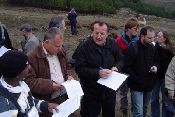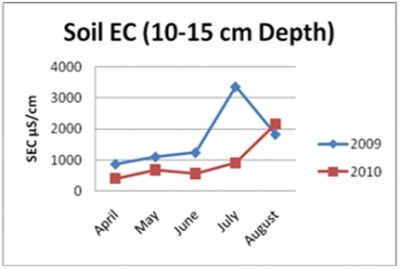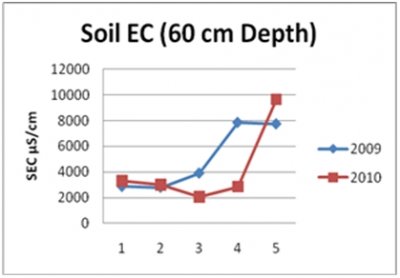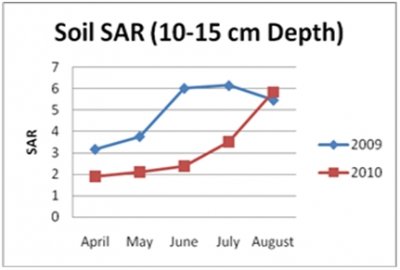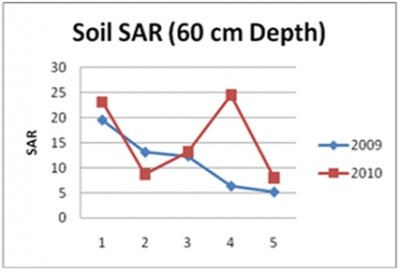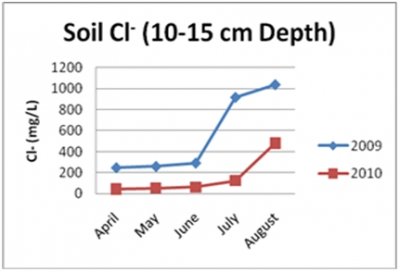|
The coastal region of the East Nestos River Delta (Maggana, northern Greece) has limited freshwater supplies although irrigation is exceptionally intensive. Studies show that there is intrusion of seawater into the coastal aquifer. The shallow brackish groundwater is in use for irrigation since the last 40-50 years, which has caused severe salinization of the soil.
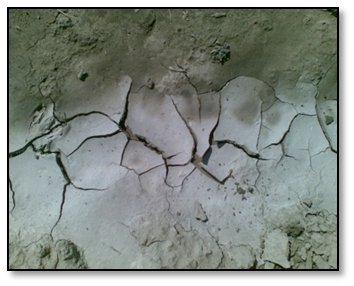 |
Apart from the chemical problems for crop growth, salinization affects the permeability of soil and causes infiltration problems, because sodium in the groundwater replaces calcium and magnesium adsorbed on the soil clays and causes dispersion of soil particles: a breakdown of aggregates and natural soils structure. Also deeper in the soil this has caused compacted layers to form. |
Salinization is very difficult to reverse, and the only possible solution in the area lies in flushing the soil with fresh water from the river systems or fresh groundwater further inland. This experiment tests the soil degradation can be reversed on a field scale and if this results in better crop performance.
Experiment: freshwater flushing after brackish groundwater irrigation
|
 |
A corn field which has been irrigating with freshwater from a local stream for the last 10 years was selected for the study. A second field which is traditionally irrigated with saline groundwater was also selected. In both fields, the data on soil physical and chemical properties and crop production was collected. The freshwater field serves as reference for the evaluation below. The saline field was irrigated with relatively fresh groundwater from a well further inland (the river was too far). In addition, different amelioration strategies (deep ploughing to break deeper compacted layers, addition of gypsum) were tested. |
The nearby well with improved water quality was selected and an electric powered pump and two sprinklers were installed for irrigation. Moisture, temperature and Electrical Conductivity sensors were installed.
Meteo data and data on groundwater were collected from 2008 to 2010 and soil samples were taken starting from August 2009 at various depths: 0-5, 5-10, 10-15, 15-20 cm, 40-50 and 60-70 cm. Laboratory analysis of the samples was conducted for EC, pH, moisture content and other soil chemical analysis. |
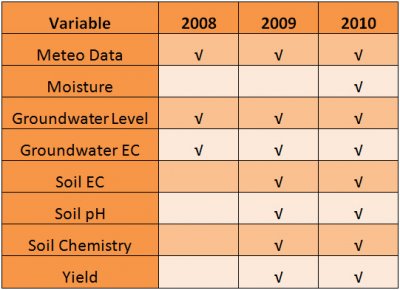 |
The top soil of these soils is sandy while between 50 cm and 1 meter bands of heavier material can be found (sandy loam and sandy clay loam). While sandy soil is less prone to soil structure loss, the sub soil is more sensitive.
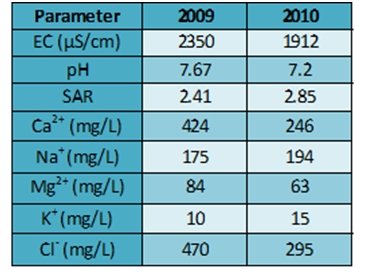 |
The chemical analysis results of the irrigation water used in 2009 and that used in 2010 shows that the latter has lower EC, pH, Ca+², Mg+²and Cl- anion concentrations but a slightly higher SAR (Sodium Adsorption Ratio, a measure for suitability of water for irrigation, higher means less suitable). These value make the fresh well irrigation water acceptable for irrigation according to international standards. |
Analysis of the soil samples shows that the EC, SAR and Cl- content in the soil in 2009 is clearly higher than in 2010, indicating a positive effect of using fresh groundwater even after one season. This depends on the general moisture content: the values all increase towards the driest month of August when the difference is less pronounced. The differences in the subsoil are less clear because of fluctuations in 2010 The SAR is even higher at soil depth 60-70 cm in 2010. The overall result shows that the improved irrigation water seems to have positive impact on almost all the parameters. The Wheat yield improved: 3.4 ton/ha in 2009 versus 4.2 ton/ha in 2010.
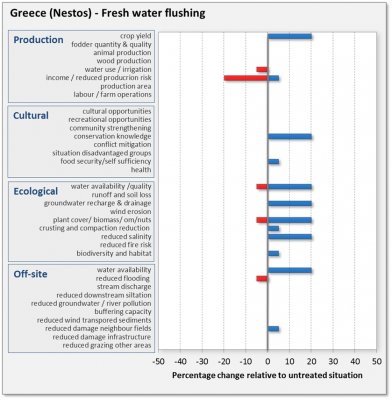 |
The results are evaluated from a production, socio-cultural and economic point of view. The bars express the estimated or measured percentage of change with respect to the reference situation. This change can be positive (blue) or negative (red). Note that this evaluation is based on the experiments, on the long term experience of the coordinating team in this area and on consultations with the farmers. |
- All groups of stakeholders were interested in the results of freshwater transport technology, especially the farmers. The evaluation indicates a medium positive effect overall: there is an increase in crop yield, but at the same time there are also increased costs because of installing an irrigation system that brings water from the streams or wells further inland to the coastal zone. Also using while the groundwater wells have relatively fresh water, there are still elevated salt contents. There are also clear improvements in soil structure and organic matter, from observations on the fresh water field. The yield and crop quality of these fields is a lot better (see photo below).
- The total cost of this technology must be taken under consideration before implementation. The reactions of stakeholders were very positive and they were keen on implementing the technology if financial aid is given. All stakeholders expecting the transport of fresh water from the nearby river Nestos.
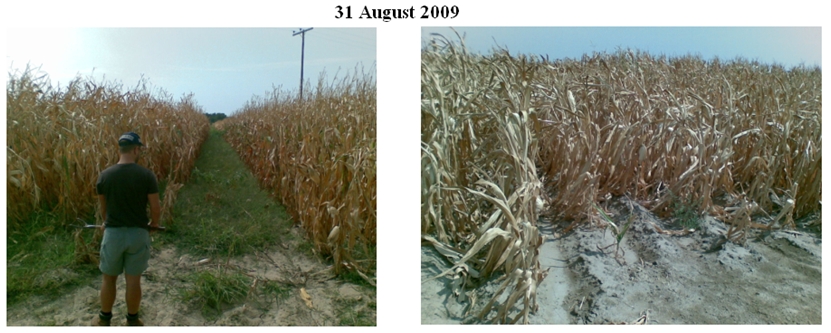
Photographic illustration of crop growth under the surface water FW (left) and groundwater irrigation GW (right).
|
Irrigation with fresh water shows an immediate positive result in both soil degradation indicators as well as in crop yield, and fresh water technology is popular and ready to be accepted in principle. However the cost of installing the irrigation systems is too high for the farmers at the moment. Moreover, the fresh water wells are maybe not a solution in the long run. Heavy use of this water might well induce a further encroachment of saline sea water further inland. This leaves the water of the river Nestos system, but it is not clear if the river system can handle such an increased use of its freshwater and how this will affect the surrounding area.
|
|

